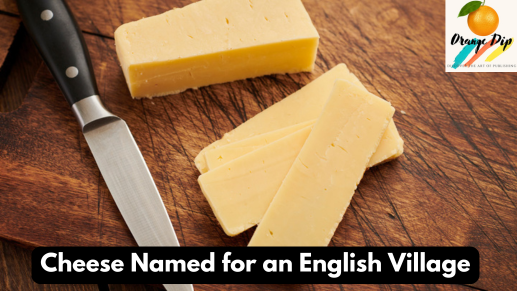To this day, competitors struggle to create cheeses of gourmet quality, combine the tastes of France, Switzerland, England, and Germany, and have such significant names that would seem even more original than the names of countries. A perfect example is the cheese produced and named after an English village; this practice attests to the symbiotic relationship between a region’s food culture and the climate of the area. Of all these, Stilton, who is crowned the “King of English Cheeses, has captured my attention, and here is how the story goes with its taste.
The Origin of Stilton: A Cheese Named for an English Village
Cheese named for an English village implies the story that connects the geography, history, and culinary tradition. Stilton is no exception. This type of blue cheese has a sharp taste and a rather grainy density; interestingly, it is named after the village of Stilton in Cambridgeshire, although it was never actually made there.
The Historical Background
Traditional types of cheese have therefore been kick-started from as early as the 18th century, and Stilton cheese is not exceptional. It was first consumed at the Bell Inn, a merchant’s house in the village of Stilton, which was a resting place for travelers going between London and the North. According to the existing legends, Cooper Thornhill who owned the inn bought the cheese for the first time on a trip to Leicestershire farm. He decided that the quality of the articles he saw was excellent, thereby starting to sell them at his inn; many travelers purchased the items and passed information about the inn to more travelers.
Although the term ‘Stilton’ became connotative with the village, it has been made in the counties of Leicestershire, Derbyshire, and Nottinghamshire. To the present, however, for a cheese to be classified as Stilton, it must be produced in one of the three aforementioned counties, from local milk and the traditional technique.
Achievement of PDO for Stilton
Stilton cheese finally got PDO status, according to the European Union, in the year 1996. This implies that only cheeses that are manufactured in the counties of Leicestershire, Derbyshire, and Nottinghamshire and which have been made in a certain way, are recognized by Trade Stilton. Such status not only helps to maintain high quality and popularity but also represents the proximity to the geographic place of production.
The peculiar features of the type of cheese called Stilton
It is thus characterized by a creamy texture and the complex flavor profile of the cheese which is usually described as sharp, earthy, and slightly nutty. It takes about nine to twelve weeks for the cheese to mature and to get its popular blue veins when Penicillium roqueforti mold is injected into the cheese. That is not all, these veins do contribute towards the cheese having a three-dimensional flavor that tends to have a hint of spice, sweetness, and a touch of salt.
There are two main types of Stilton: Blue Stilton is more recognized than White Stilton, the latter lacks the blue streaks and is slightly less pungent and smoother. Both are popular worldwide with Blue Stilton common on cheese trays, in cooking, and used with wines and port.
This paper aims to identify the cultural relevance of Stilton.
Cheese named for an English village for instance Stilton is not simply food merchandise; it is a brand. Stilton is well known in the country’s literature, music, and arts and, more importantly, is at the heart of many favorite traditional English recipes. For instance, people take it at Christmas and the perfect accompaniment is a glass of good port or sherry.
Stilton cheese is also incorporated in many of the typical English recipes such as stilton soup, stilton and broccoli quiche, and stilton and walnut bread. It is a cutter in the preparation of foods due to its ability to blend well with other foods yet has a measured powerful taste that many chefs and home chefs do appreciate.
The Stilton Cheese Makers’ Association
Hence, to ensure that Stilton produced a quality product, the Stilton Cheese Makers’ Association was established. Thus, it guarantees that all Stilton cheese manufactured conforms to the roof standards to attain PDO status. They also actively advertise and safeguard this British delicacy commonly known as Stilton.
‘Why does Stilton appeal to people globally?’
Thus, even though Stilton comes from England, its popularity has gone global, perhaps due to profiling. It is exported to other countries where people find a special taste and quality of this type of coffee. Today, Stilton is so popular that it is used in crossword and games crossword puzzles and games such as crossword in the popular New York Times where clues such as ‘a cheese named for an English village’ will lead you to the answer, Stilton.
Stilton: Customers & Foods
Perhaps one of the delights of Stilton is finding out how nearly every food and beverage can be combined with this cheese. It forms a very sharp color complement to different foods including pears, apples, nuts honey, and many more. It is also that Stilton is often used as an accompaniment to wines especially sweet dessert wines or wines such as Sauternes ‘or port wines. The cheese is salty and has a pungent taste which cuts through the sweetness and subcentral taste of these wines to give a satisfying tasting session.
Final Words
Stilton is not only the cheese named for an English village but a real pride of British gastronomy. Today, Stilton still has not deviated from where it all started in the 18th century but has evolved into cheese that is popularly enjoyed around the world. No matter if it is being used for a cheese board in a recipe or just on its own, Stilton is very diligently indeed a taste of tradition, heritage, history, and master craftsmanship.
FAQs
1. To what British village is authentic Stilton cheese attributed?
Interestingly, what is today known as Stilton has never been made in this village of the same name. The original Stilton cheese is produced in Leicestershire, Derbyshire, and Nottinghamshire only.
2. Specifically, what are the features of Stilton cheese?
Stilton is esteemed for its smooth and rich consistency with blue streaks and sharp taste. For it to qualify as a genuine Stilton, it has to be made from local Milk and has to follow the traditional methods in specific counties.
3. Is it possible to take a tour of the village of Stilton and get to see where this cheese is produced?
There you can stroll around the village of Stilton; however, the cheese is not made there. However, the village has rather interesting origins and is well known due to the eponymous cheese.
Stay in touch to get more updates & news on Orangedip!


